
Creating a Unique Tactic in FM23
A walkthrough on building a unique tactic with the tools at your disposal.
Read more: Creating a Unique Tactic in FM23“Tactics mean doing what you can with what you have.”
Saul Alinsky
Introduction
When taking over at a new club, one of the first jobs as an incumbent manager is to decide on a tactic that your team will play with. There are many ways to go about this.
You could create a tactic inspired by real life managers, looking to emulate the style of play used by the best coaches in the world. This can be really fun, but managers like Pep Guardiola have had many years and abundant resources to build a team in their vision.
Some people download ‘plug-and-play’ tactics, which is also fine. This is a game, and if making tactics isn’t for you that’s ok – play your game how you want.
Perhaps you know the team you’re playing with and are already acquainted with their strengths. This makes tactic-creation easier, as you can mimic what they do on the pitch. But maybe you’d prefer to try something different?
Your other option is to devise something yourself. Spending a bit of time assessing a team and creating a system that suits them is one of my favourite parts of Football Manager. This is especially important at teams where resources aren’t exactly abundant. Without the budget, you can’t afford to make widescale changes. You have to work with what you’ve got.
I’ve seen plenty of guides explaining how to create tactics in Football Manager. Most of them advise on ‘assessing’ your squad, then picking a suitable style. But what does that really look like? How do you assess a team?
And what’s the best way to go about creating a tactic when you don’t know where to start?

To find out, I decided to pick a team at random and create a tactic from scratch. I’ll show my process as I assess the squad, and explain my decision-making. To finish up I’ll play 5 games with them and see how effective the tactic is. I don’t necessarily have a strict order for this, but I do spend time on it. Before pressing continue on the first day, deciding on an initial system is vital.
It saves a lot of headache later on when you realize your team couldn’t pass wind, and Tiki-Taka maybe isn’t for them.
So, I loaded up a random team selector and got to work.
The team I was given?
Keflavík, in the Besta deild karla, Iceland’s top division.
I’ve never heard of them (sorry Keflavík fans!) and I haven’t played in the Icelandic division before. That’s a good starting point, and means I’m uninfluenced by previous knowledge.
Our manager, Pikir Tactiksson, will be taking charge of the team for the start of the 2022 season.
The Goal
Before I get into the main body of this article, it’s important to outline what we’re looking to achieve. What is the purpose of a tactic, and why use one over another? Why bother doing this at all?
Regardless of shape, style or individual roles, the primary aim of your system is to win football matches. To win is to succeed, and success is the goal of any manager. How you do so is highly situational, and there isn’t a ‘right’ way. But that doesn’t mean their won’t be a ‘most effective’ way.
In CrusaderTsar’s article on disciplined and sensible management he discusses how football is like a game of cards –
Like in a card game, you put your “best” cards into the draw pile. Then mix them with some “bad” cards that your opponent throws in (opposition tactics, etc.). Throw in some “handicap” cards (bad morale, matchday rain). Then shuffle them all. After this, you hope that the probability is on your side when it’s your turn to draw from this deck. The best you can do is stack your odds and hope that you draw your good cards. And avoid the bad cards that help the opposition win. In other words, you won’t win every hand. So temper your expectations.
CrusaderTsar
That way of thinking is the basis of this method of tactic creation. Whatever players you have at your disposal, emphasizing their strengths is vital. If you don’t, you’re just dealing yourself a bad hand.
In the 2017/18 season, Rafa Benitez guided Newcastle to a 10th place finish with limited resources.
He described football management as being like owning a short blanket:
If you cover your head, your feet are cold; if you cover your feet, your head is cold.
Rafa Benitez
His tenure at Newcastle didn’t exactly end in glory, but the sentiment remains the same. You aren’t going to excel at everything, so stack the odds in your favour by playing to your strengths.
Even the bigger clubs filled with superstars have to make a choice – do we cover our head, or our feet?
Starting Out at Keflavík
To start with, we’ll be taking some advice from our Assistant Manager. Opening the tactics screen prompts them to recommend a style for the team. For Keflavík, we’re advised to play a ‘Fluid Counter-Attack’ style. The assistant recommends a 4-3-3 shape, so we go with that too. I then selected the ‘pick best XI’ option and leave it there. It won’t be perfect, but they know a lot more about the players than I do at this point.
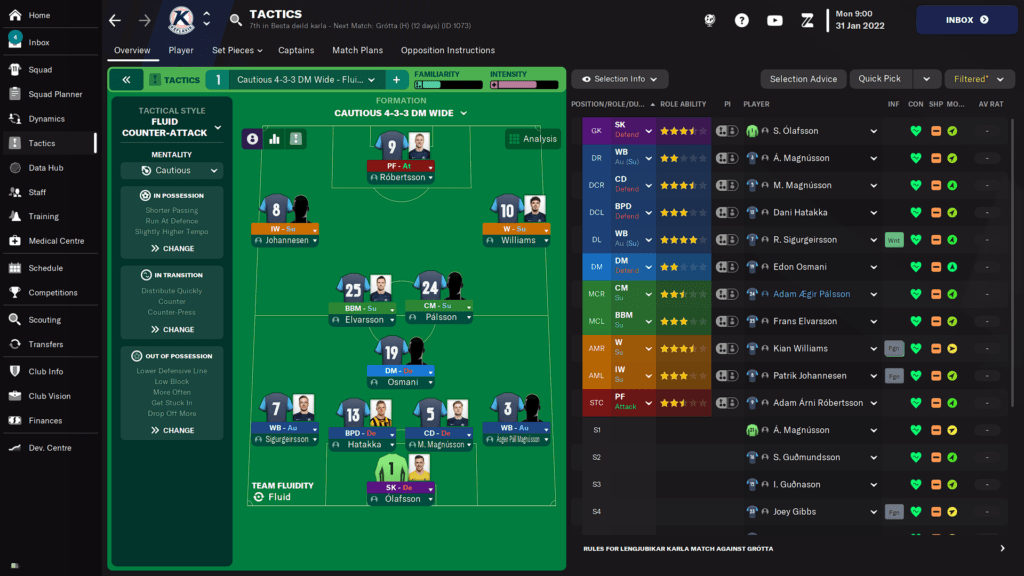
Next, we’ll start assessing the squad. It’s important to know your team inside and out if you want to maximize their potential.
I usually start with a glance at the competition preview screen. This gives us an indication of where we’re expected to finish this season. It let’s us get an idea of our strength relative to the rest of the league. Also, if you have any players in the media Dream XI, they’re probably going to be pretty good.
Keflavík are estimated to finish 11th, which is second to bottom. Being a weaker team we’re likely to be under the cosh a fair bit. We’ll take this into account as we form our system.
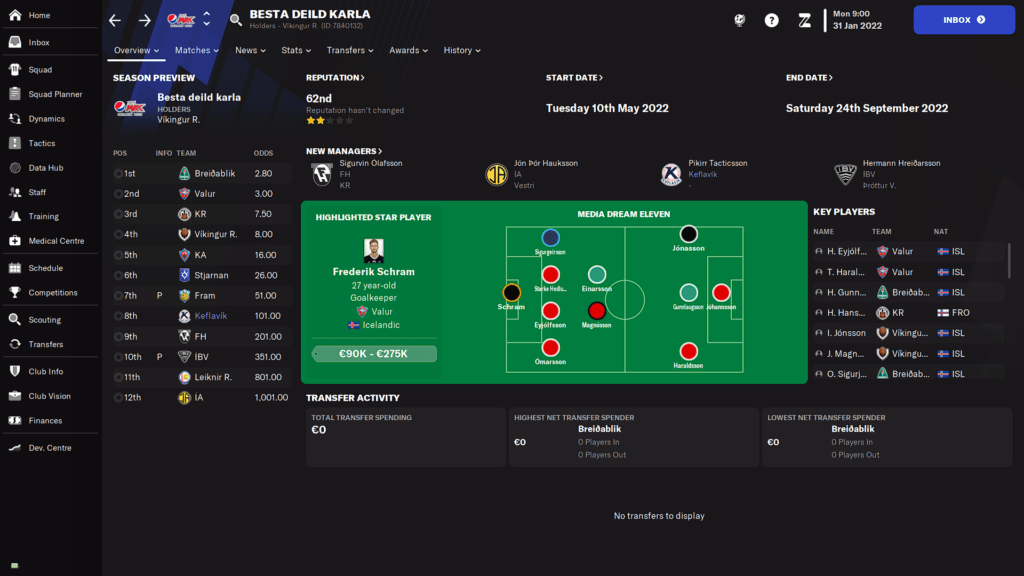
Comparison
Next, I’ll take a look at the comparison screen in the squad planner menu. This is a good way of seeing what your team are good at in comparison to the rest of the league, and is a good way to form a basic idea of how they’re going to play.
The first thing that stands out is that our team is the tallest and heaviest in the league on average.

That tells me that the team are probably aerially dominant and strong. That is unless we just have one freak of nature who’s upsetting the balance.
Next, I’ll look through the defence/midfield/attack tabs. These tell us how the teams score in different attributes that relate to these phases of play. The tick boxes for each position tell us which players are being judged. I usually untick goalkeepers first, and look at the outfield players as a whole before narrowing down to specific positions.
Defence
From the defence tab, we can see that the team as a whole are fast – some of the fastest in the league in fact. They also boast above average jumping reach and are strong, as we expected. The assistant manager’s recommendation of counter-attacking seems correct so far.
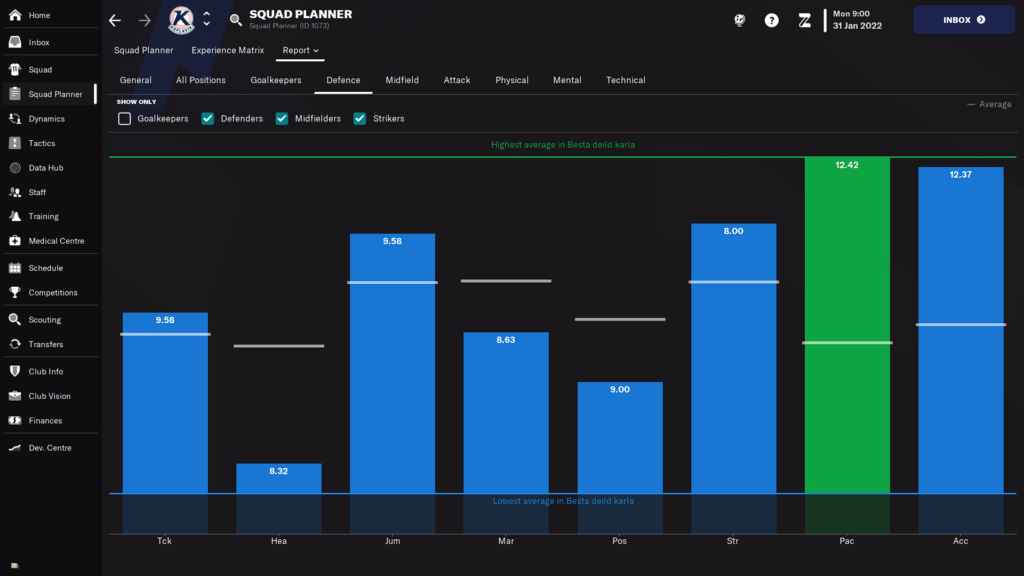
Midfield
Next up is the midfield tab. This should give us an idea of how well the team operate when the ball is in the middle third of the pitch.
The team in general are competent decision makers, and have above average vision but below average passing ability. This says they can make good decisions on the fly, and can spot an opportunity to progress the ball. They aren’t the best at passing the ball. They also don’t work particularly well as a team, and lack stamina.
I find it important to outline what they can‘t do as well as what they can do. Low passing and teamwork throws high-passing possession based systems out the window. Low stamina means we’d be disadvantaging ourselves by having them run around constantly. Therefore, an aggressive press-heavy tactic probably won’t work either.
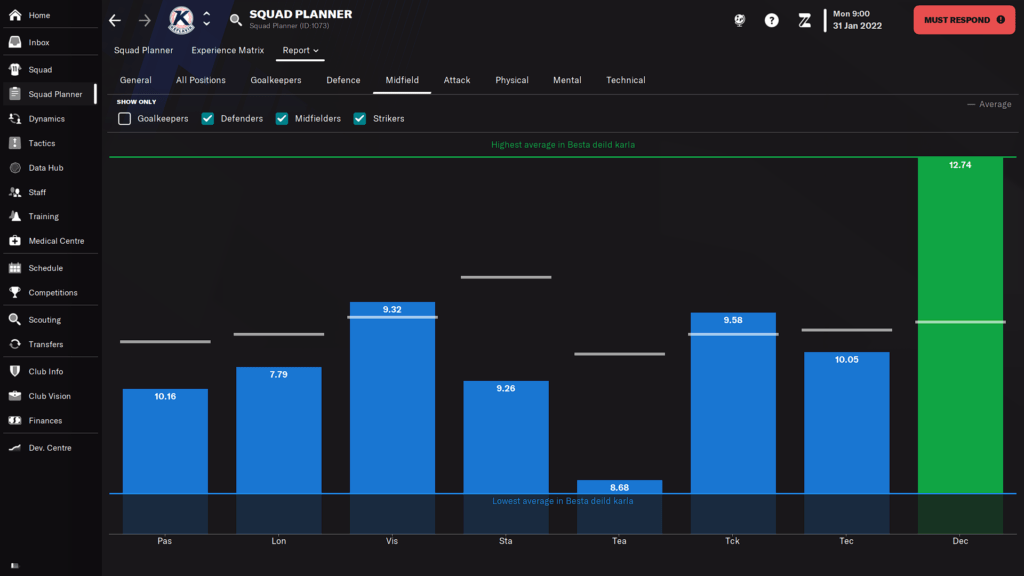
Attack
The attack page tells us how the team will look in the final third. Again, physically dominant – but we know this already. A standout here is ‘Heading’, a technical attribute. The team might have impressive jumping reach, but I don’t think we’ll score a lot of goals from headed chances.
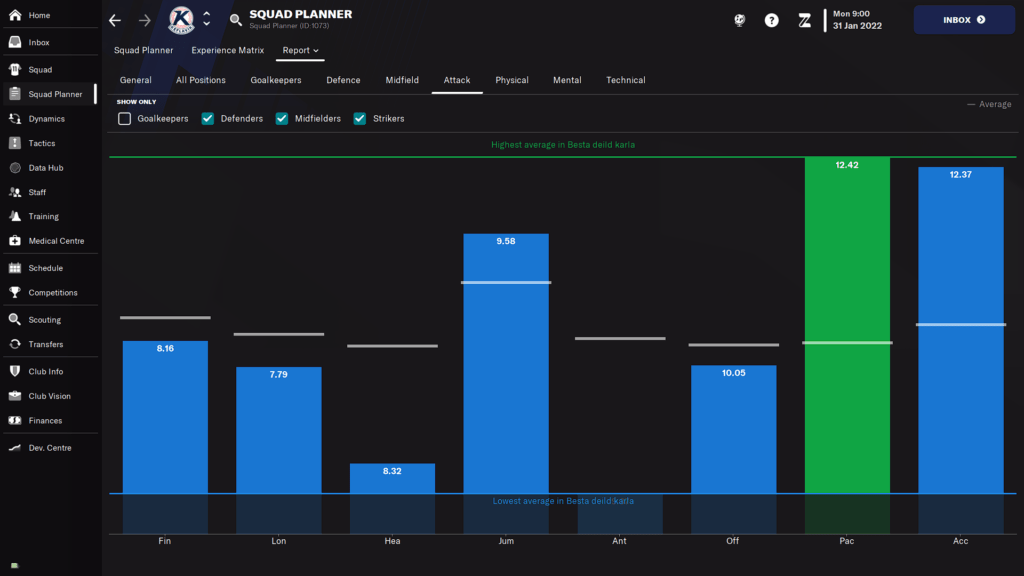
Narrowing Things Down
So far, we’re looking at a counter-attacking tactic that makes use of the high levels of physicality the team possess. We’ll be looking to use their speed, decision-making and strength to move the ball quickly in attacking phases. That’s a good starting point, but ‘counter-attacking’ is a broad description, and covers some wildly varying systems. We have to narrow things down to specific positions to get a clearer picture.
For this, I select the position in the tick boxes – Defenders/Midfielders/Strikers, and then look at their corresponding tabs. I do this for each attribute category so we know exactly what they’re good at, and what they’re not.
Strikers
As we’re looking to play on the counter, we’ll start by looking at our strikers.
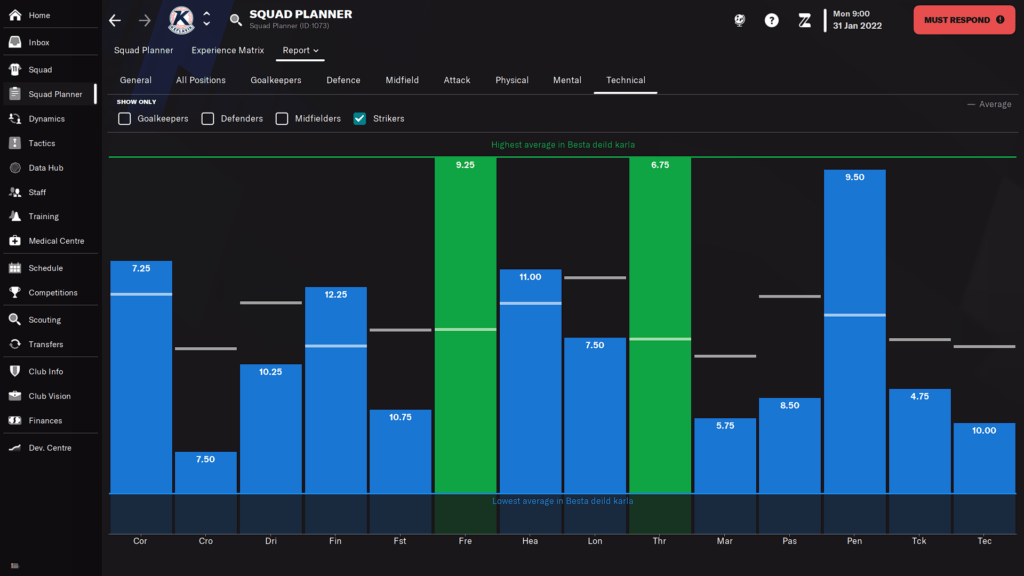
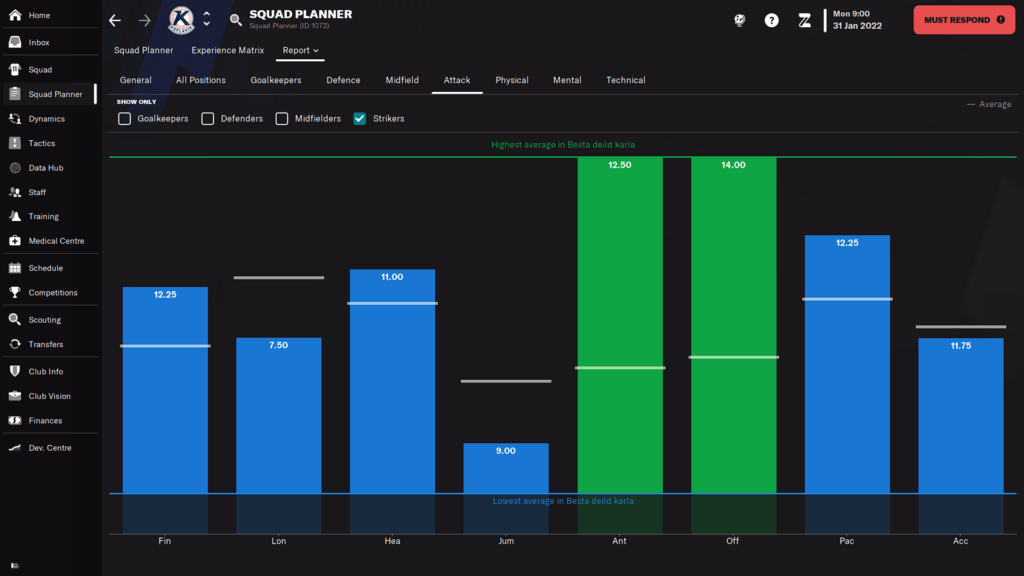
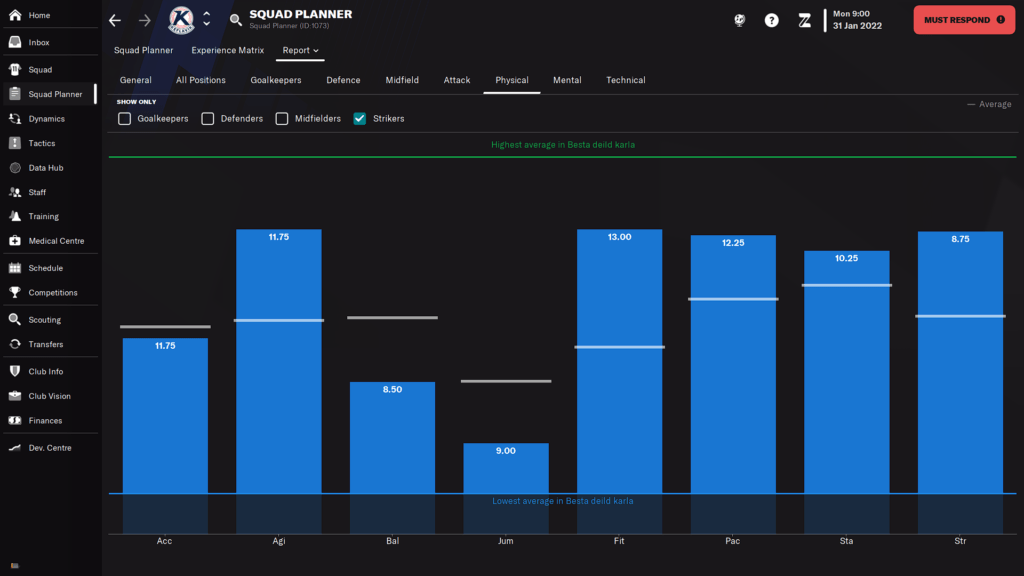

Our strikers are quick, but perhaps lack a little bit of acceleration. They don’t have the best jumping reach, but they look to have excellent movement off the ball. This is the importance of delving deeper and learning about your team.
Our counter attacking style won’t be hoof-ball. Instead, we’ll look to play flat and vertically to feed them with through balls, utilizing the excellent movement of our strikers. They’ll be there to cap off moves rather than build-up play. We want them getting in behind, using pace, strength and well timed runs to play off the shoulder.
They will be goal scorers first and foremost, total-football be damned.
Midfielders
Next, we’ll have a look at the midfielders, and decide what function they’ll have.
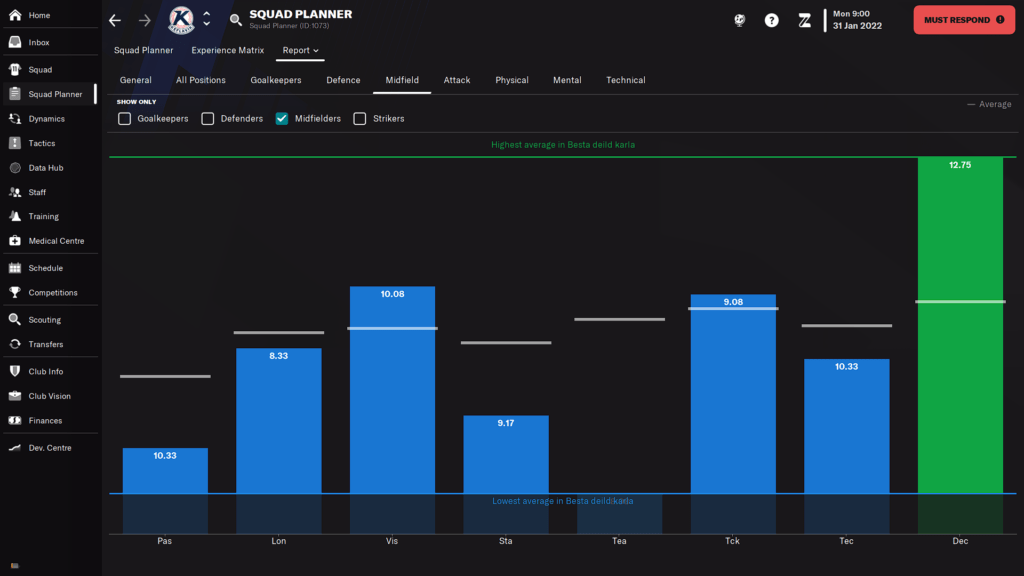



Again, decent decision making and speed, but not the hardest working or technical midfield. I think we’ll be losing the midfield battle more often than not, but they should be able to receive the ball and lay it off to our attacking outlets. I don’t think we’ll be relying on them to be industrious in winning the ball back, more as a fulcrum to progress the ball quickly towards the top of the field.
Defenders
Lastly, we’ll take a look at our defenders.


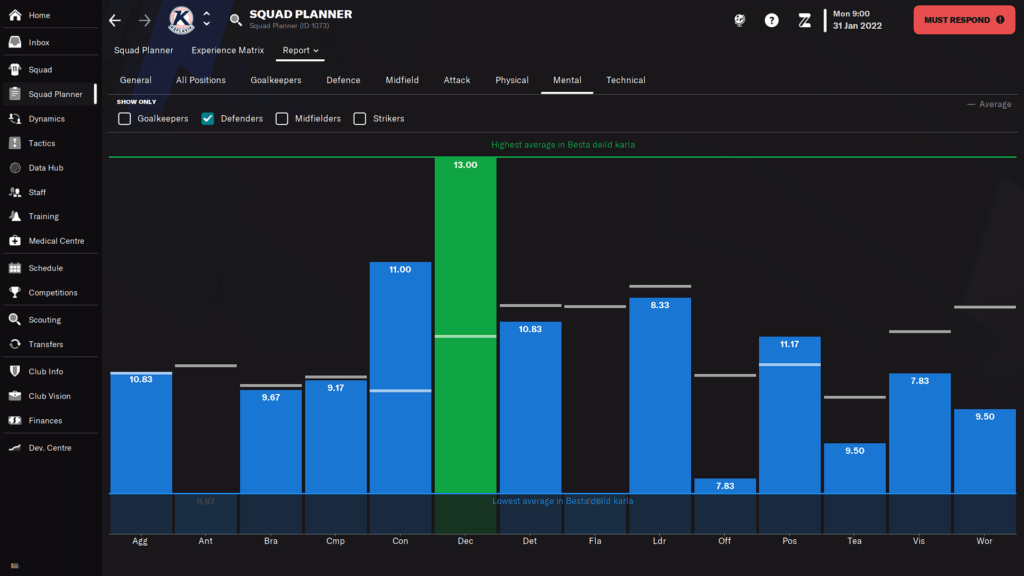

Fitting in with the theme, our defenders are fast and strong, but don’t have the best staying power. They look to be strong mentally, and capable of passing the ball around. They’re probably fast enough to play a high line, but that would be taking space away from our forwards.
Tying it All Together
So, after assessing the squad as a whole, we know this:
- We’ll be relying heavily on the squad’s excellent physical presence in all phases of play;
- The team aren’t the fittest, and as such would be better suited to bursts of physicality, not prolonged periods of intensity;
- Overall, the team don’t work well together but can make decisions effectively;
- Our attacking players are very quick and excellent in their movement, but not great in the air.
- Our weakest area is the midfield;
- We have a competent defence.
So, we’ll most likely stick to the counter-attacking style, but change it to accommodate for a lack of aerial presence up front. We’ll look to use physicality and movement to transition the ball quickly up the pitch and into goal scoring opportunities. We’ll most likely look to bypass our midfield, as it’s a weak point, so play will have to be focused elsewhere. A capable defence means we can probably rely on them to stop the opposition rather than needing extra support. Also, we know our tactic probably won’t rely on relentlessly press the opposition.
Assessing Individual Players
The comparison pages are vital for getting an overall idea about the team. Now, we need to find out more about the individual players.
I find it helps to pick 4/5 key players in your squad. These are players who fit the style we’re looking to play, and who we’ll be building the system around.
Here, you’re looking to highlight key players across the field who will be fundamental to the way you play and make the most out of their strengths in your system. While I normally advise staying away from star ratings, anybody with 4/5 stars is probably going to be one of these players. Still, it’s important to look deeper at what exactly they’re good at.
I’ve picked a few of our star players at Keflavik who’ll be the key components of our counter-attacking tactic. I’m glad I don’t have to attempt to pronounce their names.
The best young player at the club is probably Rúnar Þór Sigurgeirsson.
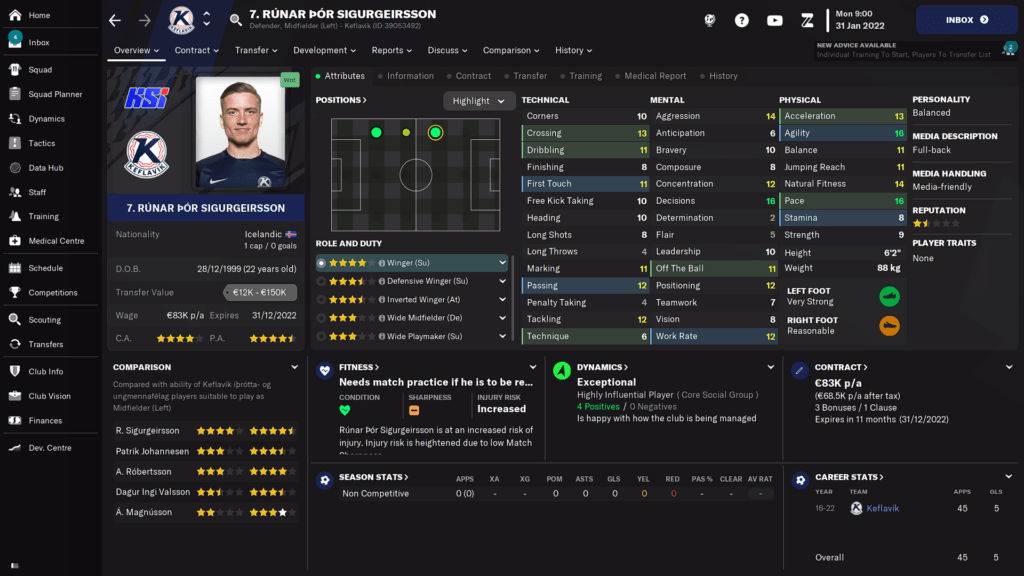
A natural down the left wing, Sigurgeirsson is quick and nimble. Capable of using either foot, He’s an excellent decision maker, and can pick out a cross. He’s not shy of working hard, but he doesn’t look like he’ll be able to run around for 90 minutes. While he can play at full-back, I want him playing in a forward-thinking role. This should make the most of his excellent pace and crossing ability.

Frans Elvarsson is a diamond in an otherwise pretty rough midfield. He’s a grafter, and his decision making, vision, technique and passing make him look to be an excellent playmaker. He’s natural at defensive midfield, so we’ll probably play him in a deeper role. A player like this is great to have in a counterattacking system. As our strikers make runs into channels, he’ll be able to fire off precise through balls to them.
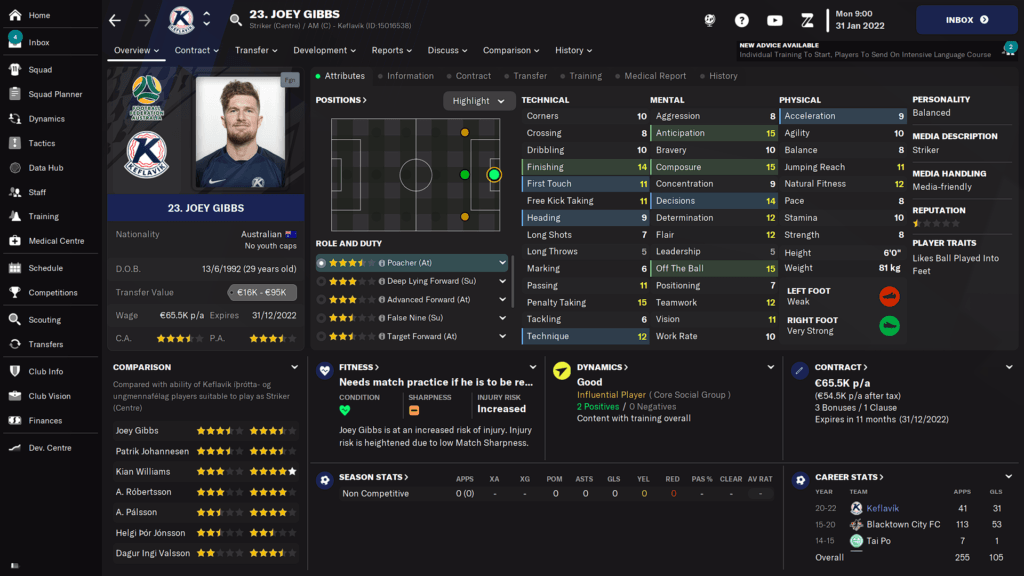
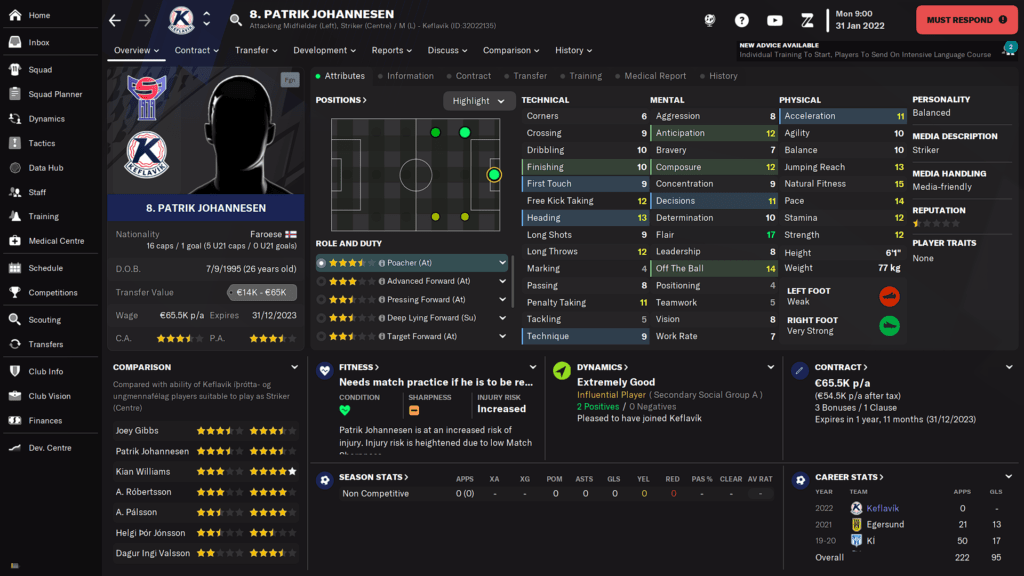
Receiving those progressive passes will be one of Patrik Johannesen or Joey Gibbs. Gibbs is the more intelligent player, but both look to be capable of moving off the ball. Johannesen in comparison is a more physical type, and outscores Gibbs in every physical attribute. Notable is Gibbs’ playmaking ability, so he can operate in a supporting role if required.
Also, props to Johannesen for his 17 flair – Jogo Bonito!

At the back we have Goalkeeper Sindri Kristinn Ólafsson, a competent sweeper keeper. He likes to come off his line, commands his area well and should beat most strikers in the air. He’s got great reflexes to boot. Having a goalkeeper of this strength is good, as it means we can rely on him to stop the opposition attack. This means we can invite a little bit more pressure and not have to worry about leaking goals.
So, our key players fit the system we want to use, as expected. That’s good, and now we know our squad a lot better. Now, we can go back to our initial tactic and make some changes.
Adjusting the Initial Tactic
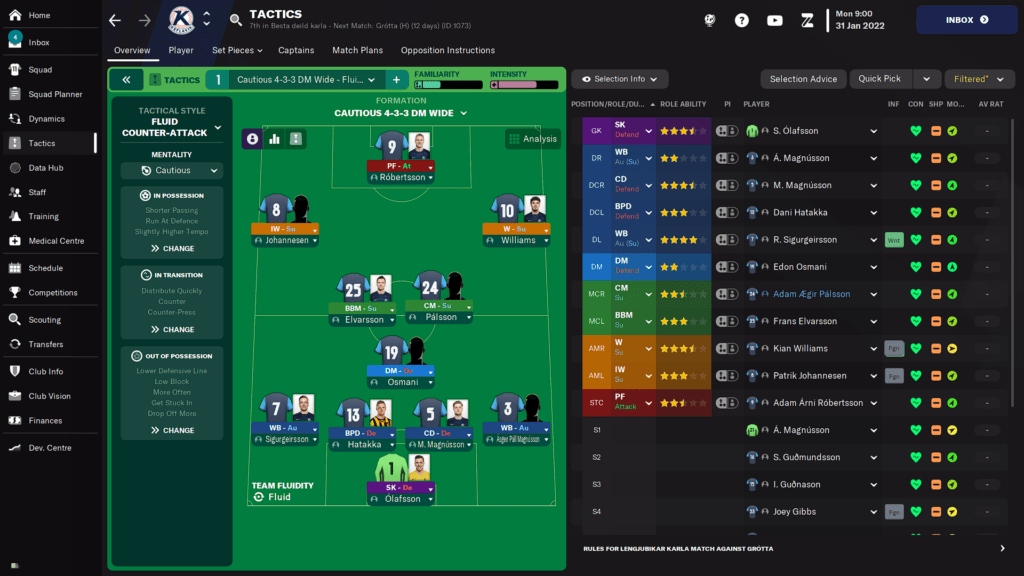
Before messing with the player’s and team roles, we need to finalise the team shape.
The shape, or formation, of your team is actually one of defining factors in your tactical style. The shape of your team has a big influence on how they play. While theoretically anything is possible, it’s best to pick a shape that suits the style you want.
My 4-5-1 system at Lokomotive Leipzig relied on controlling possession through safe passing and drawing opposition markers out of position. The effect wouldn’t have been the same if I had used a 5-3-2, for example, as the short passing would’ve been easier to intercept with more space between players.
For Keflavik, while a 4-3-3 can work for counter-attacking, I think there are better options. We know we have a weak midfield so having 3 players through the middle is unnecessary if they’re going to get beat anyway. We also know we have good defenders, and a goalkeeper who can sweep well and not a weak point. That means we can stick with a back 4.
The solution? I think our best bet would be a 4-4-2. It makes use of our wide players, who are really good, and allows us to have an extra attacker up front to work the ball towards in our quick transition.
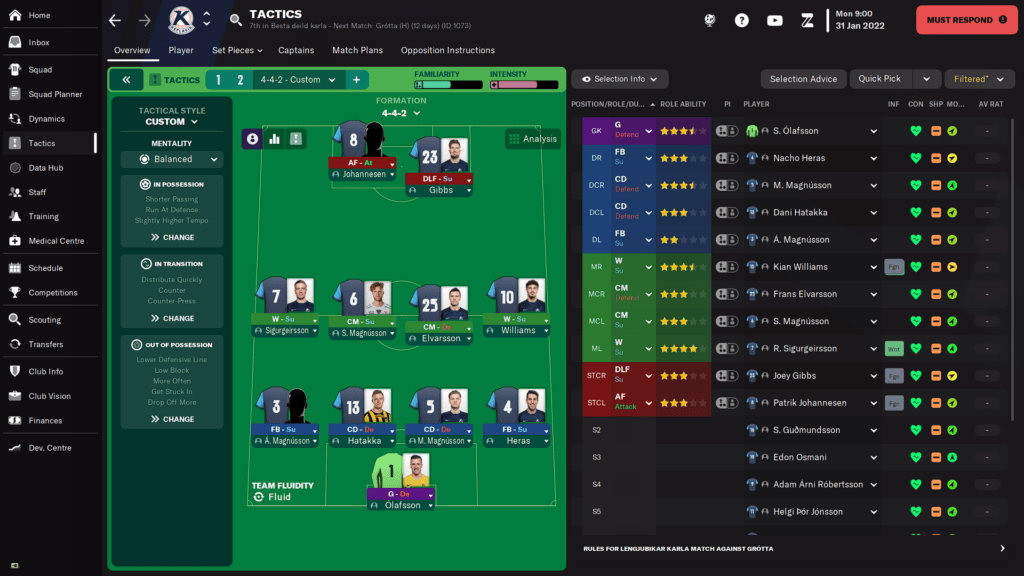
Team Instructions
Next, we’ll adjust the team instructions based on what we’ve figured out so far. An important thing to note here is that less is usually more. It’s rare that having every instruction set is better, and often just confuses things. We’re also looking to bring an element of balance to the team. Finding balance is important. Swinging too far towards one way of playing can lead to you being over or under aggressive.
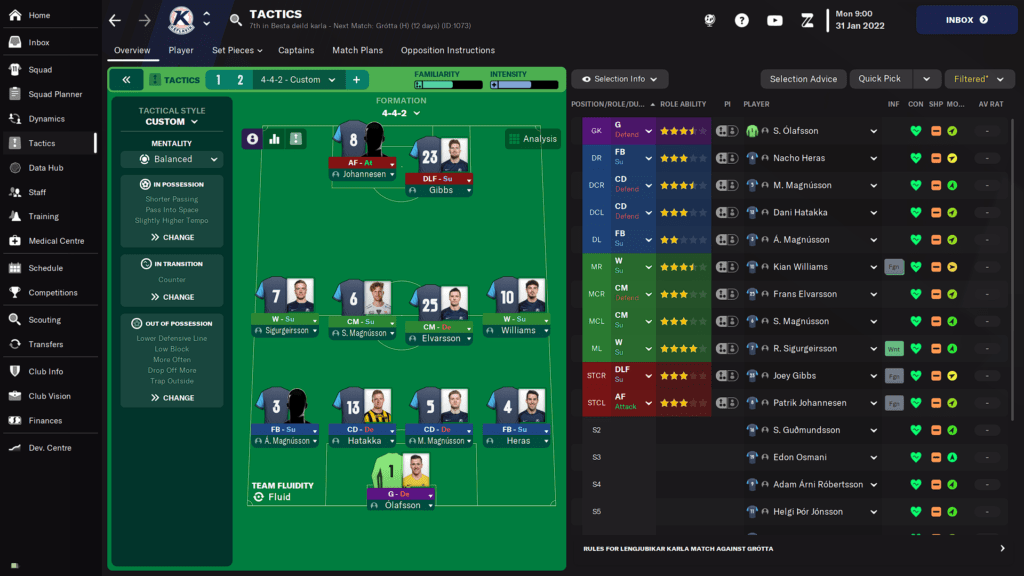
In Possession
I’ve taken off run at defence and added pass into space. While I do want our wide players carrying the ball forward, they will do this anyway as per their positional instructions. I don’t want every player trying to progress the ball through dribbling. The midfield, for example, shouldn’t be on the ball too long. We want them to pass the ball quickly to one of our carriers.
I’ve also added pass into space, to make use of our strikers off-the-ball movement and our pace out wide. Short passing and a higher tempo is kept on to keep things moving swiftly, and reduce the amount of long balls.
In Transition
The only in-transition instruction I want on is ‘counter’. I wanted to allow the players a little bit of freedom in whether they decide to press or drop off. They’re good at making decisions, so I trust them to work to the situation. The only thing I need them to do is progress the ball forward as quick as they can to instigate counter-attacks.
Out of Possession
In defence, we’ll be playing with a low-block. It should work well in a counterattacking system with good defenders. I’m happy to invite a bit of pressure to open up space at the top of the field. I’ve kept the ‘more often’ instruction in regards to triggering the press, as I don’t want us to be too passive. This is a good example of the balance I mentioned earlier.
I’ve set the team instruction to balanced, further allowing my players decision-making independence.
Setting Player Roles
Lastly, we’re going to tweak some player roles. Two players can occupy the same position, but the role assigned to them can vary massively. It’s important that we select roles to reflect how we want the player in that position to act.
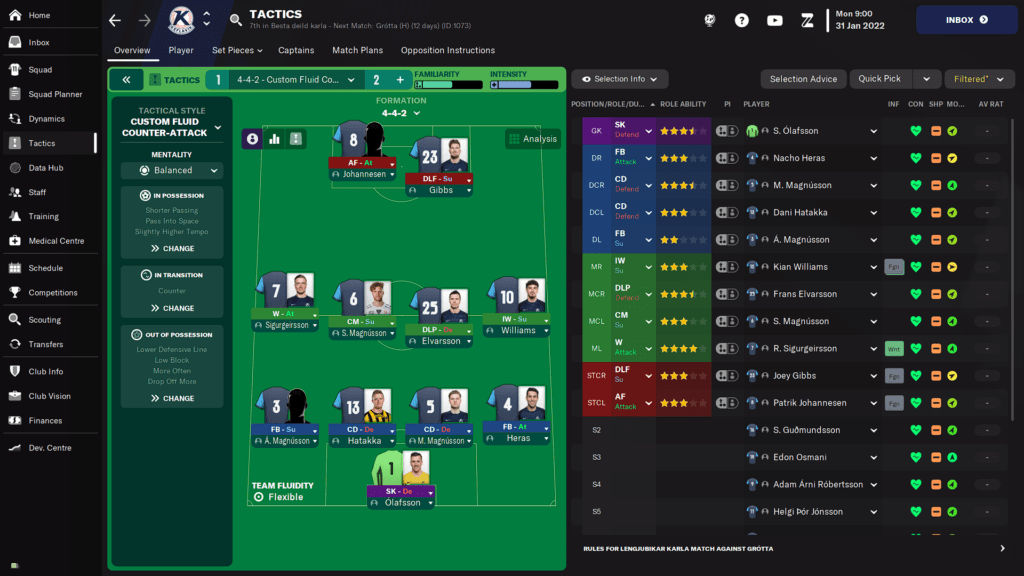
Like the Team Instructions, there is a bit of a balancing act to this. You want to pick roles that are suitable for your players but also for your system. Usually, it’s better to go with the greater good and what benefits the team overall.
Luckily, at Keflavík, most of the players fit into the roles that I want them to.
This is also the point where testing will become necessary. There’s a few positions here where I’d look to play about with the roles a bit in pre-season to see what works best. I’ve tried to keep it fairly simple with Keflavík, as our players aren’t great and I’d rather they just do the basics well.
Defence
Starting at the back, goalkeeper Olafsson is a confident sweeper and as we’re playing with a back four that’s the role I’d like him to occupy – being aggressive and snuffing out opposition attacks rather than waiting passively.
I’ve kept our two Centre Backs on the CD (D) role, as first and foremost there job is to hold the back line and well… defend. I would maybe play about with trying one of them (probably Hatakka) as a Ball-Playing Defender once I know how the team are going to move while on the pitch.
Full-back was a more difficult position to pick. Sigurgeirsson is our best Left-Back, but he’s also our best Left-Winger. Johannesen can play on the left wing, but I want him playing in the front two. So the best other option was Magnusson, and this area is probably a weak link in the team. I’ve assigned him the FB (S) role, to try and keep things as simple as possible. If it doesn’t work, I’ve always got the option of shifting Sigurgeirsson there and maybe playing him with the FB (A) role.
On the right-hand side, we’ve got Heras as a FB (A), where he’ll be looking to overlap his wing partner and get crosses into the box.
With a back 4 and nobody in the Defensive Midfielder slot, I tend to prefer the FB role over WB or CWB for the higher focus on defending the flanks.
Midfield
In the midfield, Elvarsson is deployed in a DLP (D) role, and I’m hoping he’ll be the fulcrum of a lot of our attacks. Note that he’s on the side of the more attacking full-back, as his deeper position will provide cover if Heras wants to move forwards. Options for his partner are fairly limited, so I’ve opted for Magnusson in a CM (S) role. He’s not great but as long as he’s competent enough, helps in both phases of play and can pick out simple passes then I’m happy.
On the wings we’ve got Sigurgeirsson on the left and Williams on the right. I’ve spoken about Sigurgeirsson already, and selected the Attack duty for him as I want him on the ball a lot, pinging balls into the box. Williams isn’t as good at delivery, but he’s a capable dribbler. Because of this, I opted for the IW (S) role. This should see him cutting inside more to overload the centre and allow Heras to overlap him on the right.
Attack
For our strike partnership, Gibbs will be playing the supporting role. I’ve chosen for him to be a Deep-Lying forward rather than a Target Man due to his lack of aerial presence. I want him dropping deeper to receive the ball and linking up the midfield with the attack. I debated for a while whether to play his partner, Johannesen, as a poacher or Advanced Forward. Again, it’s something I’ll play about with, but I think his good movement suits him playing off the shoulder and moving in channels rather than hovering around the box. He starts as an Advanced Forward, and all the player roles are set.
Testing the Tactic Out
So, that’s the tactic more or less finalised. It’s impossible to know exactly how it will perform in a match before using it. Having spent the time to make sure it’s suitable and makes the most of the players I’ve got means I’m more confident. It’s better to have a solid foundation that you know will be effective rather than attempting to achieve perfection straight away.
All that’s left now is to try the tactic out.
Our first 5 games are in the Lengjubikar Karla, the Icelandic League cup.
Up first are 2nd Division Grotta in a frosty home ground. Unperturbed by the bitter Icelandic winter, Keflavík come out on top, 3-1.
The first goal of the season comes in the form of this spectacular lob from Patrik Johannesen, using all 17 points of that Flair attribute.
A brace from Johannesen, a goal from Gibbs and 2 assists for Attacking Right-Back Heras. Johannesen’s goals were both scored following a quick counter after a turnover in possession. We’re playing exactly as I intended.
Grotta’s goal came from a corner kick, which isn’t linked to our tactical style.
CB Magnus Magnusson also gets himself suspended, which is annoying as we don’t have any real replacements.
The second game finishes a 3-2 loss to HK away from home, with Elvarsson having to fit in at centre-back due to a lack of options. I will point out that all their goals came from set pieces, which for the purposes of this article I haven’t configured.
we finish the first 5 games with 10 points, and 2nd in our group. If we extrapolate that form over the course of a 22 game season, we’d finish with 44 points – enough for 2nd place in the 2022 season in real life. Not entirely accurate, but it gives an idea of how the tactic might perform,
We scored 10 goals in total, and conceded 4. Of these, 5 came from Patrik Johannesen, and 4 from his strike partner Joey Gibbs.
6 assists come from our wide players, which is exactly what we wanted – to bypass the midfield and focus on our strengths which is down the wings.
In terms of tweaks, I didn’t have to change anything. I was happy that the system was working well – if it’s not broken, don’t fix it.
Summary
So, it looks like our tactic for Keflavík has worked pretty well. Taking a bit of time to properly assess the squad has paid dividends. When I first started playing Football Manager, I know I struggled to create a tactic that would fit the team I had at my disposal. I’d often try to shoehorn players into a tactic I liked rather than play to their strengths. Since then, I’ve developed the method I described in this article, and rarely do I find myself having a bad start to a new season.
There is plenty of information out there to assist you in picking a system that suits your squad. For me, the hard part is figuring out what they’re good at, not relating their strengths to a particular style. I opted not to write this as a step-by-step guide as I don’t think that would be appropriate – you should get a feel for your team as you go along, and make decisions gradually as you gather information.
My ultimate aim for this piece was to show that it’s perfectly possible to create a successful, unique tactic with any team without investment. I spent about 2 hours examining and tweaking before I pressed continue on my save with Keflavík, and the results speak for themselves. Beforehand, I knew nothing about the team or any of their players. After just 5 games, we’re in title contending form and I was confident I had a tactic that was functional and successful.
I hope this article helps you somewhat in assessing your team in detail and getting the best out of the players you have available.
For more guides, articles and the best Football Manager content out there, follow Dictate the Game on twitter:
Dictate The Game (@DictateTheGame) / Twitter



10 thoughts on “Creating a Unique Tactic in FM23”
Thank you for the introduction. I will use this as an inspiration as I have been recently promoted with my team and instead of being the favorite to win the title, I will probably find myself battling for avoiding relegation. I am just wondering, what would be the key attributes to look for, when wanting to play possession based football/counter attack ? I am right now struggling to find the balance in my save. Thanks !
Hi Max,
Hope I’m not replying too late! Key attributes vary by position, but in no particular order:
For a possession based system you’d need high levels of passing (naturally), technique, first touch, off the ball, anticipation, decisions, and vision. I also like a high level of teamwork for a possession tactic too, as it requires a higher degree of team cohesion to hold on to the ball.
For a counter-attack, I’d focus on pace, acceleration, strength, vision, crossing, tackling, anticipation, decisions and aerial presence.
Hope this helps!
Hi, thanks for the great piece! I’m currently starting a save and when looking at my squad I’m in a weird place where compared to the rest of the league they don’t possess the technical and passing ability for possession football but simultaneously lack the physical and defensive quality of a counter attacking team. This has left me a bit unsure as to what sort of tactic to go for. Any advice?
Hi Sultan,
Its definitely an awkward situation if your team doesn’t immediately stand out as being good in any particular department. A lot of it depends on how effectively the previous manager recruited players, but my suggestion would be to focus on who might be your key players. Pick (in your opinion) your best 4/5 players who you’re certain will start almost every game. What are they good at? What role do they perform best? And how can you build the team around them to make the most of their talents? Not every player has to be perfectly suited to the tactical style you go for, sometimes its a case of best fit whilst you’re rebuilding a squad.
excellent description … I play 3 saves, the first is fm 19 I play with doncaster rovers and we are first, the tactic is 4-2-3-1, the second save is fm 20 Bristol City champoinship, currently we are 5 I play in 4-2-3- 1 and I will take a closer look at the roles and comparisons and finally there is Preston North End FM 21 and the second place in the championship also 4-2-3-1.. with the intention to be the first.. I have managed Preston for three years, Bristol only this year I took over the season and I was a Donstaster for two seasons.. I don’t think I’m bad in tactics, but I’m weaker in buying players, I simply put together a team with what I have and sometimes I buy a player.. I think it takes a lot of time to learn how to play fm.. there is a lot of people who don’t understand fm play it with play and play tactics and base their philosophy on buying and selling players, I think that Fm is a much higher level than that kind of playing.. it is necessary to learn a lot but a lot has to be thought about.. I’m talking about us who are not football players and neither coaches.. what occupies me right now is training and I think I have understood how and what.. and that I am doing training correctly.
This was awesome. I kinda wished you carried on with the save
Loved this piece, I’ve been looking for something like this for a long time. I was just wondering if you’d be able to make YouTube videos related to this, analysing players for a system a little more in depth. Easier to watch than read sometimes